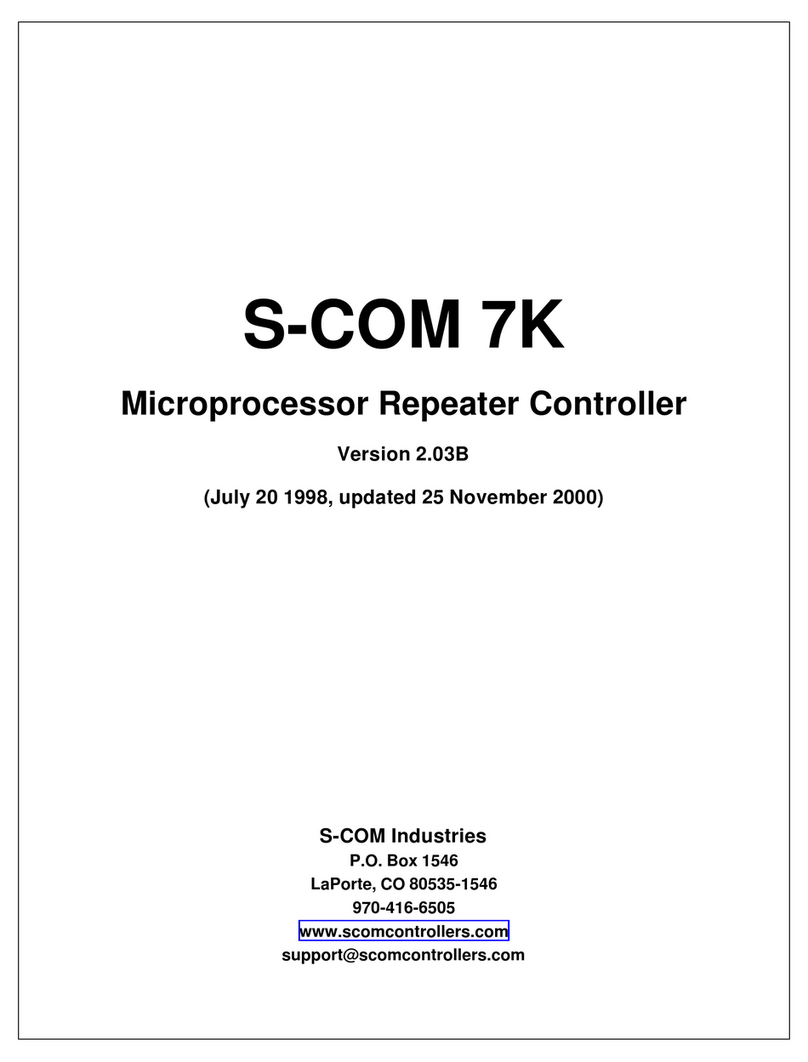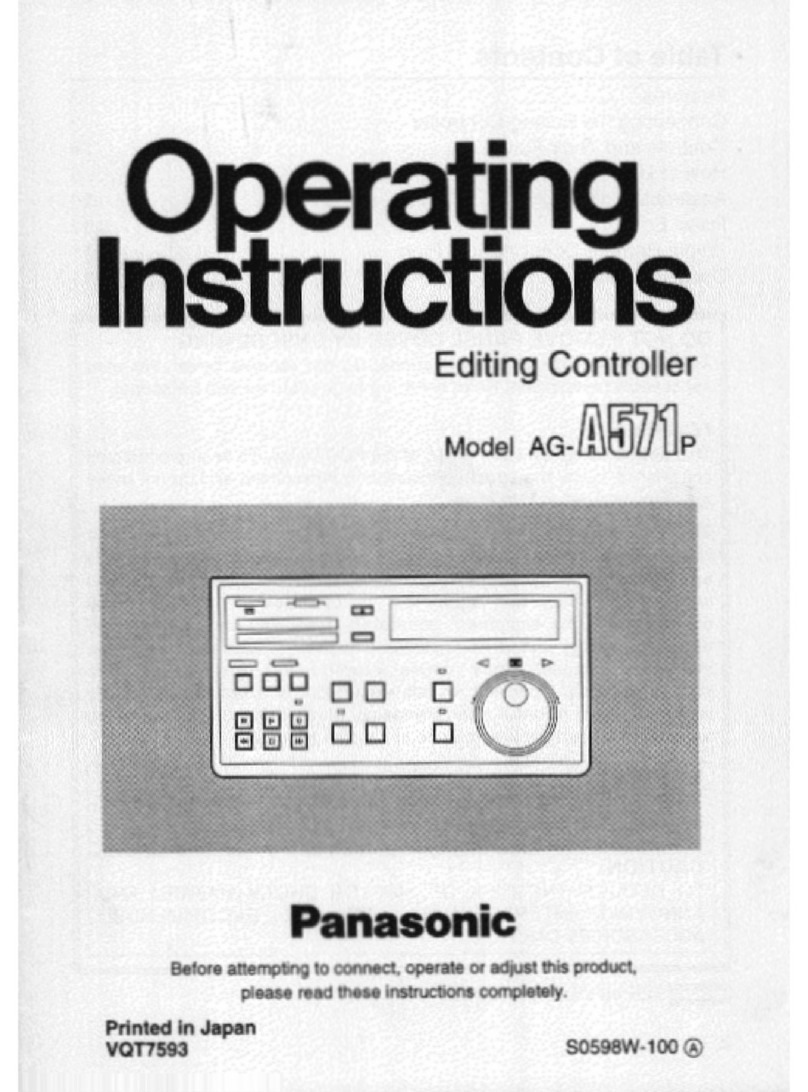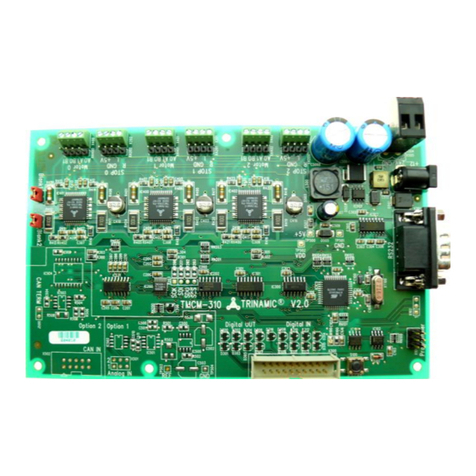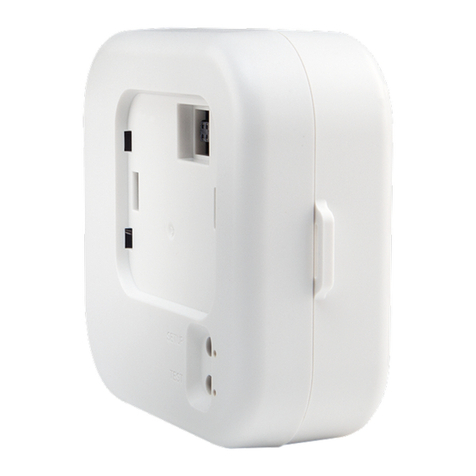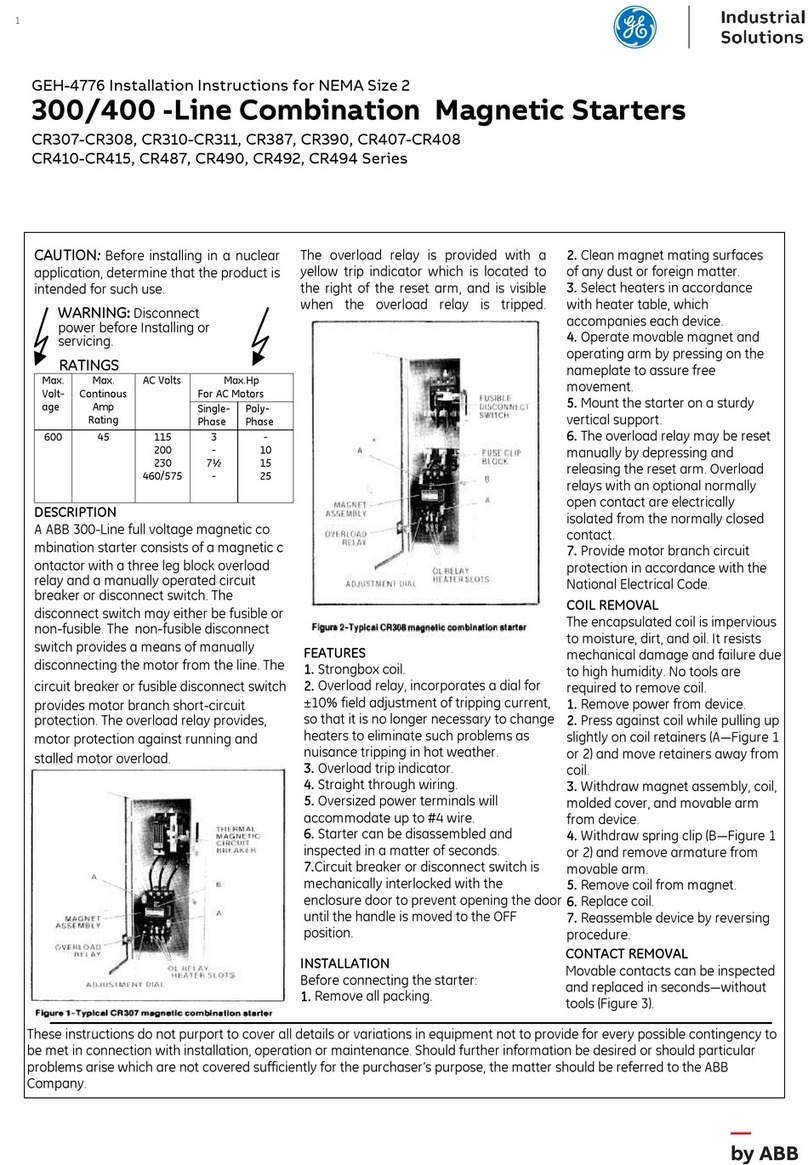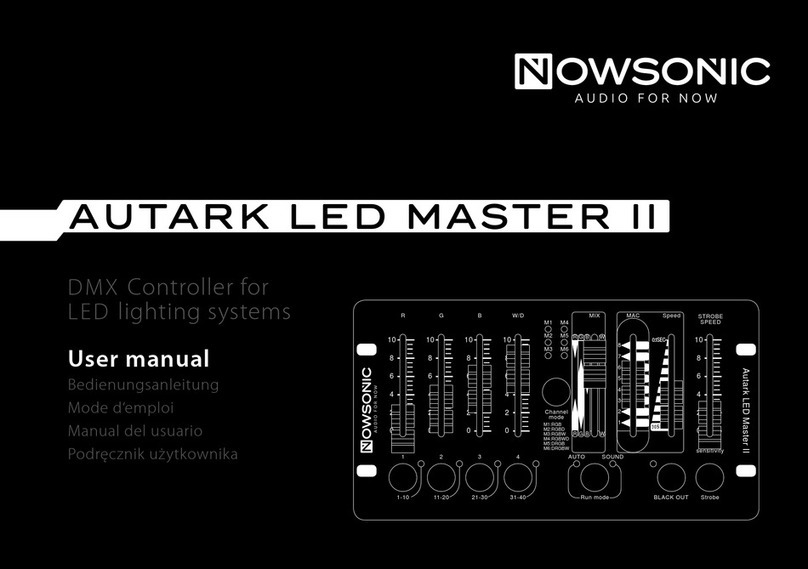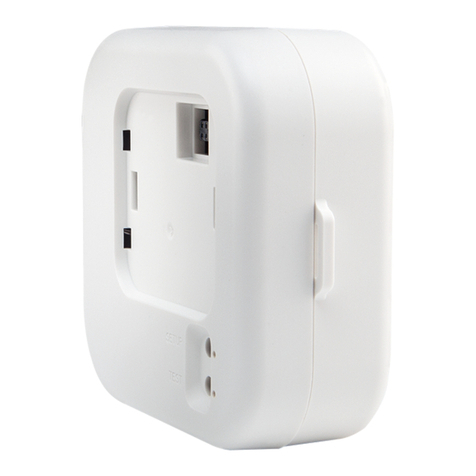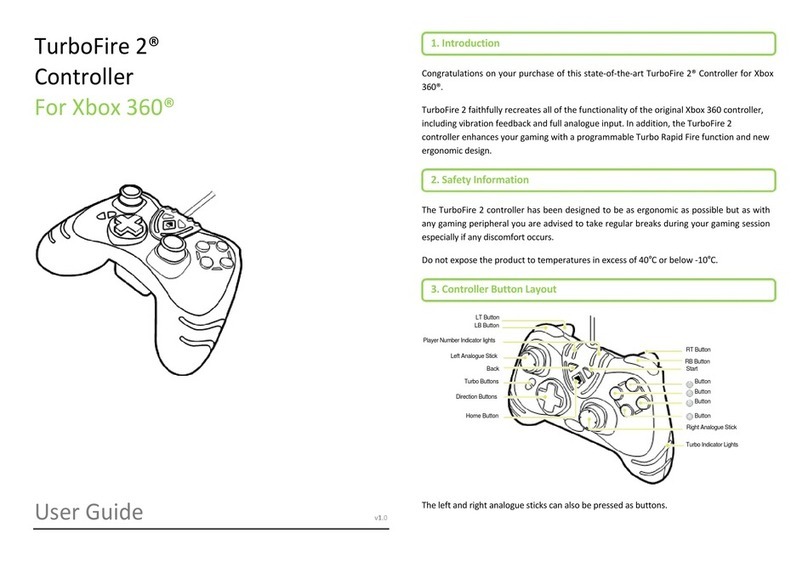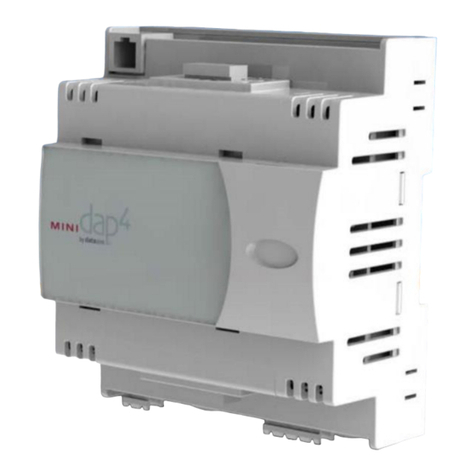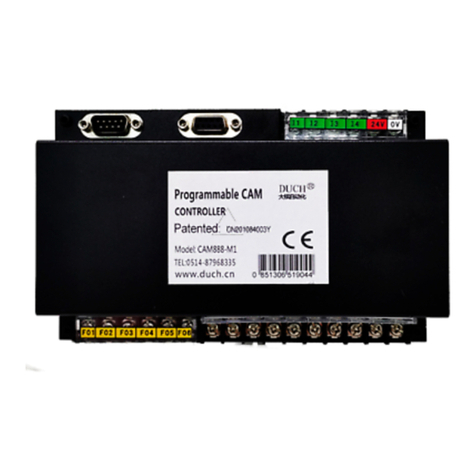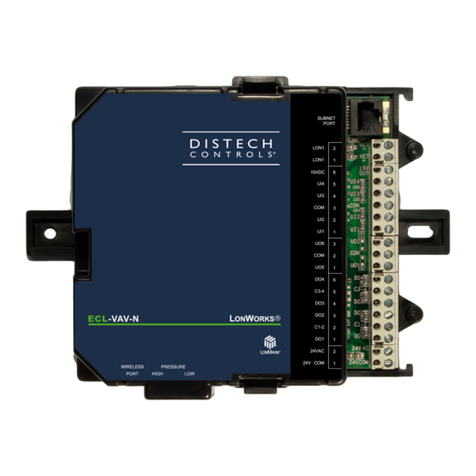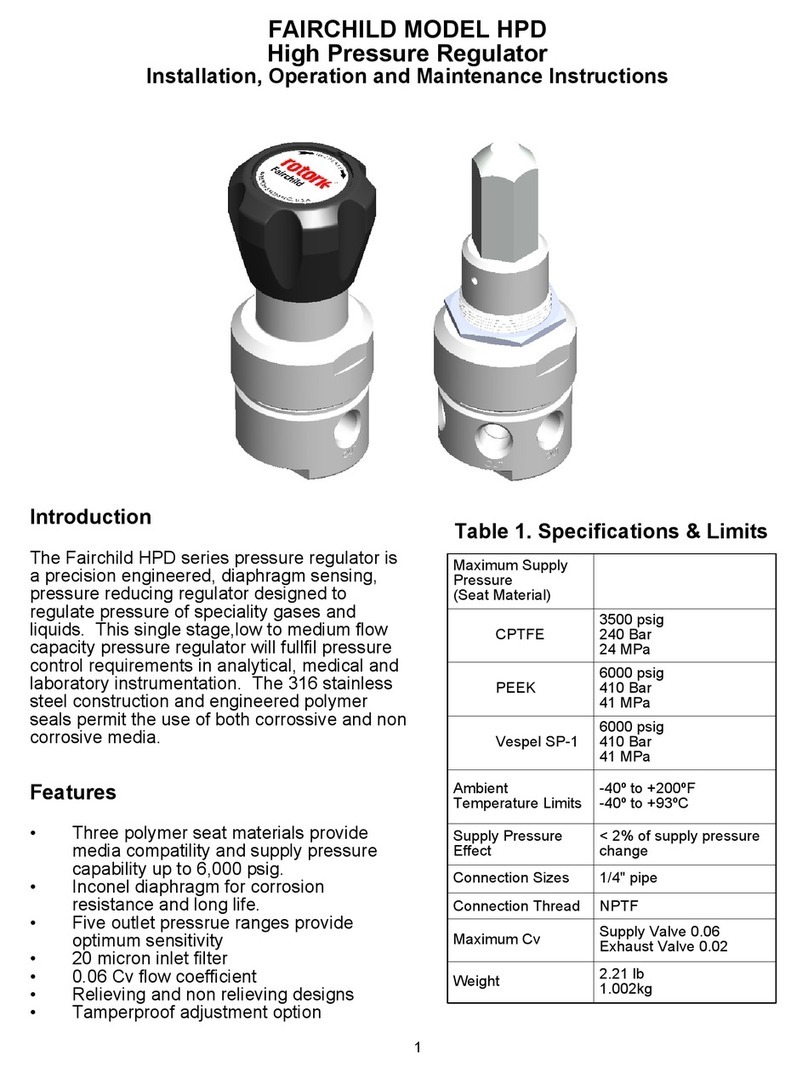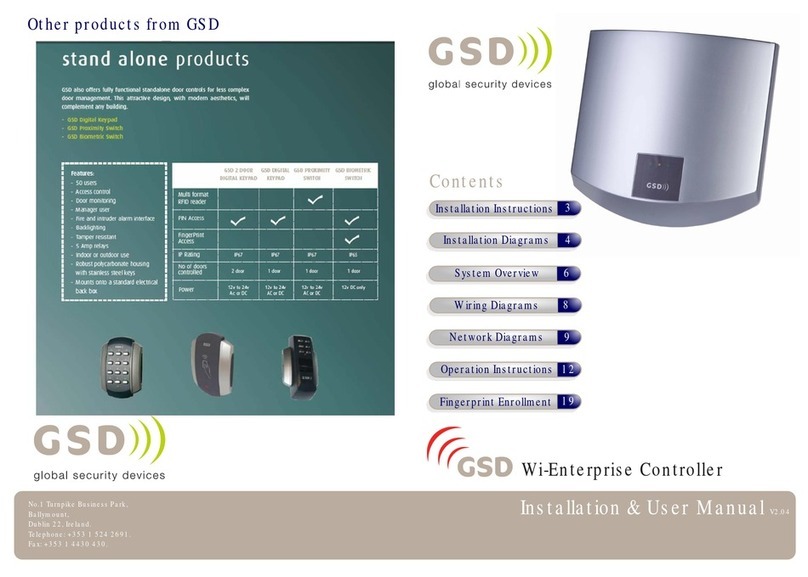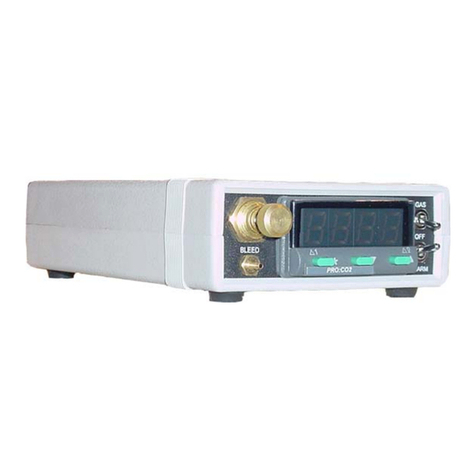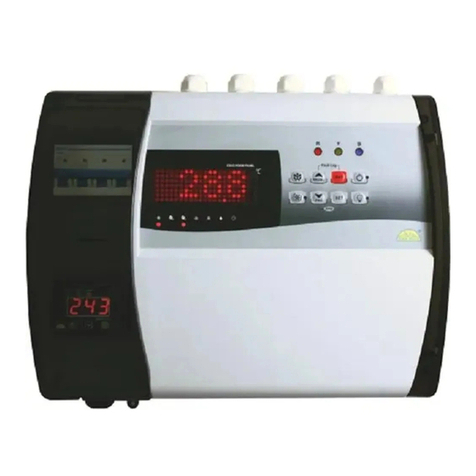S-COM S-COM 6K User manual

S-COM 6K
MICROPROCESSOR REPEATER CONTROLLER
OWNER'S MANUAL
V1.02 03-16-91
(V2.0 & V2.01 upgrades in back)
Rev. 04-10-2021
S-COM, LLC
P.O. Box 1546
LaPorte, CO 80535-1546
U.S.A.
970-416-6505
www.scomcontrollers.com

6K V1.02 03-16-91 1
IMPORTANT!
1. This product uses CMOS integrated circuits and other components that can be damaged by
static electricity. Be sure that you are properly and safely grounded, and are working at a
static-free workstation, when handling these components.
2. This product uses a lithium battery to provide power to the memory system when main
power is interrupted. This lithium battery is a primary cell. Do not attempt to recharge it!
3. The pin designations of the DB25 connector in the 6K are slightly different than the pin
designations of the DB25 connector in the 5K. Specifically, pins 16 and 18 are active
signals in the 6K; these pins are connected to ground in the 5K. Be sure you have checked
your cable and removed connections from pins 16 and 18 if you are replacing a 5K
controller with a 6K controller!

6K V1.02 03-16-91 2
DESCRIPTION
1. INTRODUCTION
The S-COM 6K is a high-quality, compact, microprocessor-based repeater controller
intended for use in amateur radio and commercial radio installations. Incorporating
advanced hardware and software designs, the 6K provides most-often-needed control
functions and powerful new features not found in any comparable-cost controller.
The 6K is fully remotely programmable with DTMF commands via the telephone or via the
receiver ports, thus eliminating the inconvenience of returning EPROMs, microcontroller ICs,
and PC boards to the factory for reprogramming. No jumpers or diodes are needed for
programming. Data is retained in non-volatile memory, ensuring that no information is lost
during power outages . . . making extra trips to the repeater site unnecessary.
2. STANDARD FEATURES
A. HARDWARE
a. Configuration
The standard 6K controller package consists of a Main Board and a Telephone Interface
Module mounted in a rackmount cabinet. A set of mating connectors and a manual
complete the basic package.
b. Cabinet
The cabinet provides mounting for the Main Board, the Telephone Interface Module Board,
and up to two optional Audio Delay Module Boards. The cabinet can be installed in a
standard 19" wide equipment rack. The cabinet is constructed from three basic parts: An
Iridite-plated chassis box, an Iridite-plated chassis cover, and a black anodized front panel.
The cabinet occupies 1-3/4" of vertical rack height, and measures about 7" deep. This
shallow cabinet may be installed in any rack, including the slim Motorola rack cabinets.
c. Main Board
The 6K Main Board measures 6"deep by 8" wide, and can operate as a stand-alone
controller. The digital portion of the board contains the microprocessor, memory, and logic
input/output circuits. The analog portion contains the DTMF encoder/decoder, audio
crosspoint switch, tone synthesis, and audio interface circuits. Two connectors, a DB25
female and a 2.5 mm DC power jack, are mounted on the Main Board. These connectors
protrude through cutouts in the rear of the cabinet, allowing the interior of the cabinet to be
free of wiring harnesses.
d. Telephone Interface Module
The Telephone Interface Module (TIM) is constructed on a 3" by 6" PC board, and adds
Autopatch, Reverse Patch, and Phone Line Control capabilities to the 6K Main Board. It is
registered with the FCC under Part 68 Rules, eliminating the need for a separate telephone

6K V1.02 03-16-91 3
coupler. Transient protection and RFI filtering is provided. The all solid-state design of the
TIM eliminates the possibility of mechanical relay failure, and the built-in electronic hybrid
allows both half-duplex and full-duplex autopatch calls. The TIM supports both regenerated
DTMF dialing and 10/20 PPS rotary dialing.
B. SOFTWARE
a. CW Identifier
The software CW Identifier stores remotely-programmable multiple call signs with ID Tail
Messages. The interval between identifications is also programmable. The CW is internally
mixed with repeat audio. The ID'er is "polite," which means that it attempts to identify only
during breaks between transmissions.
b. CW Messages and Paging Formats
Most of the CW messages are remotely programmable. CW pitch and speed is
programmable, and can even be changed within a message. The CW character set
includes alphanumerics, punctuation, and a large library of "beeps." The CW amplitude
level is set with a potentiometer.
The 6K supports single-tone (group call), two-tone sequential, 5/6-tone, and DTMF paging
formats. Separate pots allow adjustment of tone paging and DTMF paging. Pages may be
stacked for convenient call-ups of ARES members, weather spotters, DX Club members,
on-the-airmeetings, and so on.
c. Timers
All timers in the 6K are derived from the microprocessor's crystal-controlled clock circuit for
improved accuracy over other methods. Most timers are remotely programmable, including
the Courtesy Timer, Dropout Timer, Timeout timer, Autopatch Timer, etc.
d. Repeater Characteristics
The character of a repeater can be varied by choosing distinctive Courtesy Messages,
Timeout Messages, Dropout Messages, and their associated timers. The repeater can be
placed into one of several access modes, or disabled. These characteristics can be
changed by command or by a transition detected by one of the logic inputs.
e. Clock and Calendar
A CW readout of the current time and date can be commanded. The clock can be read in
either 12-hour or 24-hour format. An additional command is used to adjust the accuracy of
the clock. (Power must be provided continuously to the controller for the clock and calendar
to stay set).
f. Logic Inputs and Outputs
Logic inputs are used to detect a change of state in monitored devices at the repeater site.
Logic outputs can be manipulated by command to pulse, or latch, a controlled device at the

6K V1.02 03-16-91 4
site.
g. Command Language
Commands are given to the 6K with an easy-to-use DTMF language. Security is enhanced
with a password system, as well as programmable restrictions on DTMF decode operation.
A library of macros may be defined for the repeater's users. Macros may be created,
deleted, renamed, and modified at any time by authorized control operators.
3. OPTIONAL FEATURES
Audio Delay Module
The Audio Delay Module (model ADM/K) is constructed on a 2.1" by 2.7" PC board. It
removes squelch noise bursts and DTMF tone bursts from received audio. Up to two ADMs
may be installed in the 6K cabinet, one each for receiver #1 and receiver #2. The ADM will
delay audio in the range of 50 ms to 150 ms, adjustable via a potentiometer.

6K V1.02 03-16-91 5
LIMITED WARRANTY
This warranty gives you specific legal rights, and you may also have other rights which vary from
state to state.
COVERAGE
Except as specified below, this warranty covers all defects in material and workmanship in this
product. The following are not covered by the warranty:
1. Damage to, or deterioration of, the external cabinet.
2. Damage resulting from lightning, accident, misuse, abuse, or neglect.
3. Damage resulting from failure to follow instructions contained in your owner's
manual.
4. Damage occurring during shipment of the product (claims must be presented to the
carriers).
5. Damage resulting from repair or attempted repair by anyone other than S-COM
Industries.
6. Damage resulting from causes other than product defects, including lack of
technical skill, competence, or experience of the user.
7. Damage to any unit which has been altered or on which the serial number has been
defaced, modified or removed.
ENFORCEMENT
This warranty may be enforced only by the original purchaser.
LENGTH OF WARRANTY
For both labor and parts, this warranty will be effective for one (1) year from the date of original
purchase.
WHAT WE WILL PAY FOR
We will pay all labor and material expenses for items covered by the warranty. Payment of
shipping charges is discussed in the next section of the warranty.
HOW YOU CAN GET WARRANTY SERVICE
Your unit must be serviced by S-COM's Service Department. Please do not return your unit to
the factory without prior authorization. You must pay any shipping charges if it is necessary to
ship the product to service. However, if the necessary repairs are covered by the warranty, we will
pay the return shipping charges to any destination within the U.S. Whenever warranty service is

6K V1.02 03-16-91 6
required, you must present the original dated invoice or a photocopy.
S-COM's liability for any defective products is limited to repair or replacement of the product, at S-
COM's option.
S-COM reserves the right to make any changes in design or additions to, or improvements in, its
products without any obligation to install such additions or improvements in equipment previously
sold. S-COMfurtherreserves the right to replace defective parts under warranty with different or
improved parts.
This warranty is expressly in lieu of all other warranties, expressed or implied, including any implied
warranty of merchantability or fitness, and of all other obligations of liabilities on the part of S-COM.

6K V1.02 03-16-91 7
THEORY OF OPERATION
1. INTRODUCTION
Great care was taken in the design of your controller to make it "installer-friendly." Audio and logical
interfaces were made as universal in nature as possible, so that a minimum of external hardware is
needed to complete the installation. Although the controller's "engine" is a powerful
microprocessor, the command language is designed to be easy-to-learn and flexible.
2. PRE-PROGRAMMING (DEFAULTS)
The controller needs to know your repeater's call sign for its identifier; you must also tell it your
choice of courtesy message, timeout timer, and so on.
You can program the controlleron your workbench with an external DTMF pad and other devices to
simulate the repeater. Or, you can install the controller in your repeater and program it through one
of the receivers, or the phone line.
To make the installation easier, the controller comes "pre-programmed" with certain default
information stored in its non-volatile memory. When you have finished the installation, you may
overwrite this default information by entering DTMF commands. If it ever becomes necessary to
force the controller into its original default condition again, you can accomplish this by using the
initialize pushbutton and a power-up sequence (the procedure is explained later). This procedure
causes the microprocessor to read default information from the EPROMand write it over the old
information stored in the non-volatile memory.
3. POWER REQUIREMENTS
Your controller has only a modest power requirement, which can be supplied by the repeater's own
12 V power supply in most cases.
The controller's Main Board and Telephone Interface Module together require 12 V to 15 V DC at
less than 100 mA. (Do not exceed 15 V ordamage may occur). The controller does not require
regulated power, since it contains internal voltage regulators to create the necessary 10 V audio
supply and the 5 V digital supply. A third supply of 4.5 V is created from the 10 V audio supply, and
is used as the audio section's bias voltage.
4. REPEATER INTERFACING
Besides the power supply, the controller requires a minimum of four connections to the repeater.
They are: (1) Receiver COR; (2) Receiver Audio; (3) Transmitter PTT; and (4) Transmitter Audio.
You must eliminate any paths that might bypass the controller. In other words, there must not be
any connection from receiver audio to transmitter audio or from receiver COR to transmitter PTT
except through the controller. Otherwise, the controller will not be able to fully take charge of
repeater control functions.
If you require subaudible tone operation, you may connect a CTCSS decoder's output to the
controller. The controller will then allow you to switch the repeater from carrier operation to one of

6K V1.02 03-16-91 8
several CTCSS modes via DTMF commands.
5. 2nd RECEIVER INTERFACING
An additional receiver can be interfaced to your controller, which can act as either a link receiver or
a control receiver. If a 2nd receiver is used, the controller requires a minimum of two additional
connections. They are: (1) Receiver COR; and (2) Receiver Audio.
If you require subaudible tone operation for the 2nd receiver, you may connect a CTCSS decoder's
output to the proper input on the controller.
NOTE: The two Receiver COR inputs, the two CTCSS Decoder inputs, and the Transmitter PTT
output each has an associated dip switch on the Main Board. These switches are used to invert, or
not invert, the appropriate signal. This means that the controller can accommodate either low-
active or high-active signals.
6. EXTERNAL DEVICE INTERFACING
The controller has three Logic Inputs, each of which can monitor the state (ON or OFF) of an
external device at the repeater site. Since you can program the controller to detect either a low-to-
high transition or a high-to-low transition (or both), there is no need for the above-mentioned "invert"
switches on these inputs.
You can monitor such sensors as power failure, a high-temperature detector, a high-water detector,
or an intrusion alarm.
The controller also has three Logic Outputs, each of which can control (ON or OFF) an external
device at the repeater site. Power MOSFETs are used as the switching devices, which are
connected in an open-drain configuration (similar to transistors wired in an open-collector
configuration).
Each output can sink 75 mA when ON and withstand 40 V when OFF. All three outputs are
protected from transient damage.
7. AUDIO GATING
The controller uses an 8 x 12 analog crosspoint switch IC for audio gating. This IC operates under
instructions from the microprocessor. Since all audio sources (receivers, tone generators, and the
landline) are fed into the crosspoint switch, and since all audio loads (transmitter, tone decoder, and
landline) are driven from the crosspoint switch, the controller's audio control flexibility far exceeds
simpler designs.
8. TONE GENERATION
CW and paging tones are generated as square waves by the HD6340 Programmable Timer IC.
These square waves are shaped by a transconductance amp stage to reduce the "thumping"
characteristic heard on CW messages. (This thumping effect is caused by the DC component in
the square wave pulse train). The tone is then filtered by a 6th-order, switched-capacitor lowpass
stage to yield sine waves. The filter is under microprocessorcontrol and tracks the tone frequency.
The result is a constant-amplitude sine wave tone that can be programmed to any desired

6K V1.02 03-16-91 9
frequency in the range of 100 Hz to 3000 Hz, with an accuracy of a few Hertz. CW amplitude and
paging amplitude are separately adjustable with pots.
DTMF characters are generated via the encoder portion of the MT8880 DTMF Transceiver IC.
DTMF paging amplitude is pot-adjustable. DTMF dialing amplitude is not adjustable, and is fixed at
the level set by FCC Part 68 regulations.
9. MEMORY PROTECTION
The controller contains circuitry to protect the data stored in RAM and maintain the data during
power outages. A DS1210 IC monitors the 5 V logic supply; when it detects an out-of-tolerance
condition, the IC disables the RAM's chip-enable input. It switches the RAM's Vcc input from the
logic supply to the lithium battery when the logic supply falls too low to maintain data integrity. The
lithium battery has a lifetime of over 5 years (10 years if kept at room temperature), since the
amount of current drawn by the RAM is very low under backup conditions (a few microamperes).
10. VOLTAGE MONITOR AND WATCHDOG TIMER
The controller contains circuitry to properly start the microprocessor when power is applied, to stop
the microprocessor when power fails, and to restart the microprocessor if it gets into a runaway
condition from a spike or transient.
A DS1232 IC monitors the 5 V logic supply and asserts the microprocessor's reset input when the
supply is out of tolerance. This method is superior to simple RC reset circuits, which may not
properly reset the CPU after voltage sags (brown-outs). The reset signal that is generated by the
DS1232 drives not only the microprocessor but also other ICs to ensure that the controlled loads
will be turned off, and that a graceful power-down sequence will be observed.
The DS1232 also monitors a software-generated "watchdog" signal. This signal is created at
intervals by the execution of the microprocessor's software program. If the CPU fails to execute the
program correctly, the watchdog signal will not be generated. The DS1232 will time out in less than
one second if it does not receive the watchdog signal, and it will force the microprocessor to restart
the program.

6K V1.02 03-16-91 10
INSTALLATION
1. INTRODUCTION
You will need to prepare either one or two cables for your 6K controller. One cable is for DC power,
and is terminated with the 2.5 mm power plug provided. Since DC power may be supplied to the
6K via the other cable if desired, this first cable is optional. The 2.5 mm power jack is retained in
the 6K for the benefit of customers who are upgrading from existing 5K installations.
The other cable is for repeater connections, logic inputs and outputs, and so on. It is terminated
with the DB25P 25-pin plug provided.
This section of the manual describes the proper connections to be made between your controller
and your repeater equipment. It also describes the proper way to make the necessary audio level
adjustment.

6K V1.02 03-16-91 11
2. RECEIVER #1 (REPEATER RECEIVER) COR
Your 6K controller requires a logic signal, generated by your repeater receiver, which becomes
active when an incoming carrier is detected. This logic signal is usually called "COR" (Carrier
Operated Relay) or "COS" (Carrier Operated Switch), and is usually generated by the receiver's
noise-operated squelch circuitry. Some receivers don't have an external COR or COS connection
but do have a "channel busy" LED indicator, which works similarly.
At this point in our discussion, it is not important whether the COR signal is "low active" or "high
active" (that is, whether the signal goes to a logic low condition or a logic high condition upon carrier
detection), since the controller has sense-reversal DIP switches on the Main Board. These
switches are discussed later.
The get a better understanding of how to interface your particular COR signal to the controller, let's
examine the controller's COR input circuit. It's a general-purpose input circuit consisting of NPN
transistor Q1C and a set of three resistors. (Q1 is actually a DIP package containing four2N3904-
type transistors. R11 is a DIP package containing seven separate 10k resistors. R12 is a SIP
package containing seven 4.7k resistors with one side common.) Resistor R11F and the resistor on
pin 7 of R12 together form a roughly three-to-one voltage divider. Q1C requires about 0.7 V to turn
on. Therefore, the COR input voltage threshold is about 3 x 0.7 V = 2.1 V. Yourreceiver's COR
driver must be capable of generating a signal that swings above and below this 2 V threshold as an
incoming carrier is applied and removed, or it must have an "open-collector" type driver.
The third resistor from the group mentioned above is R13 (4.7k). R13 is a "pullup" resistor, and it's
connected between the COR Input pin and the controller's +5 V supply. The purpose of this pullup
resistor is to provide input current for transistor Q1C in installations where the COR driver is an
open-collector transistor or a pair of relay contacts ("dry" switching).
Now let's get down to specific interfaces. If your receiver's COR provides a pair of relay contacts to
indicate carrier detection, then connect one contact to the controller's COR input and connect the
other contact to ground.
If your receiver's COR provides an open-collector transistor or open-drain MOSFET, then connect
your COR output directly to the controller's COR input.
Incidentally, note that some open-collector circuits will not pull down an input circuit all the way to
ground (0 V). This is normal. When OFF, these drivers are open (high impedance). When ON,
the transistor driver will pull down to a few tenths of a volt above ground. If a Darlington transistor is
used, the output is even higherabove ground because of the Darlington's higher saturation voltage.
If the controller were designed with a low-threshold COR input, it is possible for such driver circuits
to keep the COR input "high" permanently. Remember that the 6K uses a voltage divider to raise
the minimum threshold of the COR Input from 0.7 V to 2.1 V. As long as the receiver's COR output
pulls down below 2 V, the COR input will operate properly.
If your receiver's COR circuit sources a voltage from a logic gate or op amp comparator, then you
may need to disconnect the COR Input's pullup resistor. Otherwise, it may interfere with the
operation of the receiver COR by trying to pull it to +5 V. You can check your installation by making
the connection between the receiver COR output and the 6K COR input, then measuring the
voltage at the COR input pin with both the receiver and controller powered up. If the voltage swings
above and below the 2 V threshold upon carrier detection, no problem exists. If the receiver COR

6K V1.02 03-16-91 12
voltage is normally higher than 5 V and is pulled down by the controller, or if the receiver COR
cannot pull down the input below 2 V, then you should clip one lead of the pullup resistor and lift it
from the board to prevent its making contact.
The 6K's Repeater Receiver COR input is pin 6 of J2.
The last step is to determine the "sense" of your receiver's COR signal. Does the COR signal go
"low" or "high" when an incoming carrier is detected? If the COR output goes "low" when a carrier is
applied and returns "high" when the carrier is removed, then place dip switch #1 (part of S2) in the
ON, (closed) position. If, however, the COR output goes "high" when a carrier is applied and
returns "low" when the carrier is removed, then place dip switch #1 in the OFF (open) position.

6K V1.02 03-16-91 13
3. REPEATER TRANSMITTER PTT
Your transmitter requires a "PTT" (Push-to-Talk) signal from the controller. When this signal
becomes active, the transmitter will key (transmit). At this point, it is unimportant whether your
transmitter's PTT input is "low active" or "high active", since the controller has sense-reversal
dipswitches (discussed later). Your transmitter’s PTT input should be connected to pin 10 of J2.
To get a better idea of how to interface your particular PTT input to the controller, we'll examine the
controller's PTT output circuit. This circuit consists of a power MOSFET connected as an open-
drain driver, plus a transient suppressor connected between the output and ground. The
suppressor removes transients above about 30 V, thereby protecting the MOSFET. The MOSFET
is a large (8 A)device in a TO-220 package, but it was not selected for its high current capability.
Rather, it was used because of its low ON resistance (less than 1 ohm), making it a nearly perfect
switch.
The MOSFET's drain is connected to the PTT output, and its source is grounded. When turned on,
the MOSFET appears to be a very low resistance between the output and ground. When turned
off, the MOSFET appears to be a very high impedance, isolating the output from ground. Because
of these characteristics, the PTT circuit can control transmitters with a variety of PTT inputs, from
TTL-logic-compatible to large DC relay coils.
Some transmitters, including models made by Hamtronics, MELCO (Maggiore Electronic
Laboratory), and RCA (500- and 700-series), use a powered PTT input arrangement, and cannot
be keyed by an open-drain driver. These transmitters require a positive voltage to be sourced into
their PTT inputs to key; removing the voltage unkeys the transmitter. The current requirement can
be substantial.
A simple outboard circuit can be placed between the controller's PTT output and the transmitter's
PTT input to satisfy these requirements. Connect a large PNP transistor so that its emitter goes to
the transmitter's +12 V supply, its collector goes to the transmitter's PTT input, and its base goes to
the controller's PTT output through a 2k resistor (important). Connect a 4.7k resistor across the
PNP transistor's base and emitter. If the transmitter draws little current through its PTT (500 mA or
less), you can use a 2N2904. If the transmitter draws 1 A or less, use a TIP30. When using this
outboard circuit, place dipswitch #5 (part of S2) in the ON (closed) position. Skip the next
paragraphs detailing dipswitch #5.
If you are building the outboard circuit described previously, you will need to place the PTT
dipswitch in the ON position.
If you are driving your transmitter PTT directly from the controller, you must determine the "sense"
of your transmitter's PTT input circuit. Does the transmitter key when the PTT input is driven "low,"
or does it key when the PTT input is driven "high?" (The majority of transmitters key when the PTT
input is driven low).
If your transmitter keys when the PTT input is low, and unkeys when the PTT input is high (open
circuit), then place dipswitch #5 (labeled "PTT", it's part of S2) in the ON (closed) position.
If, however, yourtransmitter keys when the PTT input is high (open circuit), and unkeys when the
PTT input is low, then place dipswitch #5 in the OFF (open) position.

6K V1.02 03-16-91 14
4. RECEIVER #1 (REPEATER RECEIVER) AUDIO
The controller requires audio from your repeater receiver, which should be connected to pin 13 of
J2.
To get a better idea of how to interface your particular receiver's audio output to the controller, let's
examine the controller's Receiver #1 audio input circuit.
This circuit consists of op amp U22D connected as an AC-coupled inverting amplifier with two
feedback resistors and one feedback capacitor. A 50k pot, R75, serves as a level-adjust pot for the
audio going into the op amp. The input impedance of this circuit depends upon the pot setting, but
will be 14k ohms or greater.
The best place to get receiver audio is the output of the receiver's first audio preamp stage (usually
the stage that follows the discriminator). This point is sometimes available at the "high" end of the
volume control pot. The preamp stage usually provides flat (de-emphasized) audio, and the low
impedance driving circuit (op amp or emitter-follower amplifier) can generate high-level audio while
driving the capacitance of shielded cable. Don't tap into the wiper of the volume control pot, since
accidental adjustment of the volume control will affect the repeat level. Tapping into the speaker
driver as an audio source is discouraged, for the same reason. Also, speaker audio contains more
distortion than audio from earlier stages.
The controller works best when driven with flat (de-emphasized) audio at a level of 700 mV rms (2
V p-p). If you provide this level, the controller's RX1 pot (R75) will be in the midrange position and
optimum audio will be fed to the internal circuits. You can adjust the RX1 pot to accommodate
other audio input levels. The controller's input acceptance range, as shipped from the factory, is
200 mV rms (0.5 V p-p) to 2 V rms (5.6 V p-p).
If your receiver's audio output level is below 200 mV, you can increase the gain of the controller's
input by cutting a resistor. Feedback resistor R24 (100k) has one lead marked with a circled letter
"A" on the PC board. You may cut this lead and lift the resistor to increase the gain by 3. The new
input acceptance range will be 70 mV rms (0.2 V p-p) to 700 mV rms (2 V p-p). The midrange
position of the RX1 pot will now correspond to 250 mV rms (0.7 V p-p).
Some repeater owners will prefer to drive the controller with pre-emphasized audio directly from the
receiver's discriminator. The controller must then de-emphasize the audio so that the audio feeding
the DTMF decoder, phone line, etc. is flat. To accomplish de-emphasis, the controller's RX1 op
amp stage must be modified to provide a -6 dB/octave rolloff response. A simple way to do this is
to replace capacitor C45 (47 pF) with a 0.01 uF if the factory gain is used. Replace C45 with a
0.0047 uF if the triple-gain modification has been done. Note that using this larger capacitor will
decrease the op amp's gain at increasing audio frequencies; you may need to make the increased-
gain modification to offset the loss created by the de-emphasis capacitor.
After you have completed the repeater receiver audio interfacing, check the audio level at pin 14 of
U22D. This is the output of the RX1 op amp. You should read about 700 mV rms (2 V p-p) of
audio when the receiver is fed a fully-deviated 1 kHz sine wave tone from a service monitor.

6K V1.02 03-16-91 15
5. REPEATER TRANSMITTER AUDIO
Your transmitter will require audio from the controller. Connect the transmitter's audio input to pin
11 of the J2 connector on the controller.
To get a better idea of how to interface your particular transmitter's audio input to the controller's
audio output, let's examine the circuit used in the controller to drive the Transmitter Audio Output.
This circuit consists of two cascaded op amp stages. The first op amp, U23D, is wired as an audio
summer (mixer) and has three inputs from the audio crosspoint switch, U27. (The controller's
software program can switch audio sources into these mixed inputs. One input would carry repeat
audio, for example, while another would carry the CW ID tones).
The second op amp, U23A, is used as an audio driver. The output impedance of this stage is 600
ohms.
A 50k pot, R80, is connected between the two op amp stages and serves as the master gain pot for
all transmitter audio.
The audio voltage that the driver develops across the transmitter audio input depends upon the
load impedance presented by the transmitter's audio input. If the transmitter presents a load of 10k
ohms or greater, the controller's audio output level will be adjustable from 200 mV rms (0.5 V p-p) to
2.4 V rms (6.7 V p-p). If the transmitter presents a load of 600 ohms, the controller's audio output
level will be adjustable from 100 mV rms (0.3 V p-p) to 1.2 V rms (3.4 V p-p). Note that in most 600-
ohms systems, the nominal level is 0 dBm (775 mV rms). This would correspond to the 85%
clockwise position of pot R80.
In the above discussion, the lower voltage level corresponds to the 10% clockwise pot position.
The higher voltage level corresponds to the 100% clockwise pot position.
If you are driving the microphone input, or some other low-level (sensitive) input stage in your
transmitter, you will probably have to reduce the gain of the controller's audio driver stage. This can
be accomplished by cutting a resistor. Resistor R59 (27k) is an input resistor to the second op amp,
and has one lead marked with a circled letter "C" on the PC board. You may cut this lead and lift
the resistor to decrease the gain by a factor of about 4. This modification decreases all audio sent
to the transmitter.
If the transmitter presents a load of 10k ohms or greater, the controller's new audio output level will
be adjustable from 55 mV rms (0.2 V p-p) to 580 mV rms (1.6 V p-p). If the transmitter presents a
load of 600 ohms, the controller's audio output level will be adjustable from 27 mV rms (0.1 V p-p)
to 290 mV rms (0.8 V p-p).
As before, the lower voltage level corresponds to the 10% clockwise pot position. The higher
voltage level corresponds to the 100% clockwise pot position.
Although it is always a good idea to use shielded cable between the controller's audio connections
and the repeater's audio connections, it is especially important to do so when driving sensitive
microphone inputs in transmitters.

6K V1.02 03-16-91 16
6. REPEATER CTCSS DECODER
CTCSS, or Continuous Tone-Controlled Squelch System, is a convenient problem solver for users
and owners in many parts of the country where the bands are overcrowded with repeaters and RFI.
In addition, your controller allows CTCSS to be required as a qualifier for entering DTMF
commands, thus increasing the security of the repeater system.
Well-known trademarked names for CTCSS include "PL" and "Private Line" (Motorola), "Channel
Guard" (General Electric), and "Call Guard" (Johnson). Your repeater may already have a CTCSS
decoder built in, or you may wish to install one of the add-on boards readily available from a
number of sources. A good example is the TS-32P from Communications Specialists, Inc., of
Orange, CA (telephone 1-800-854-0547). The TS-32P is crystal-controlled forstability, and allows
dipswitch selection of one of 32 CTCSS tone frequencies.
The CTCSS decoder should be installed in your repeater receiver following the instructions
provided by the decoder manufacturer. You will need to connect the decoder's audio input directly
to the receiver's discriminatoroutput. The decoder provides a logic output, usually an open-
collector transistor driver, which goes either "low" or "high" upon detection of CTCSS. This signal
should be connected to pin 4 of the controller's J2 connector.
The controller's CTCSS Decoder input circuitry is designed exactly like the RX1 COR input. The
transistor in this case is Q2A, the voltage divider is made up of R11B and the resistor on pin 4 of
R12, and the pullup resistor is R15. You may wish to refer back to the "RECEIVER #1 COR"
section of this manual fora discussion of the hardware design of the input circuit.
To check your CTCSS decoder interface, power up your receiver, CTCSS decoder, and the
controller. Measure the voltage at pin 4 of J2. This voltage must swing above the 2.1 V threshold
as the incoming CTCSS tone is applied and removed.
You must also determine the "sense" of your CTCSS decoder output. Does the output go "low" or
"high" when the correct CTCSS tone is received? If the output goes "low" when the tone is
detected and returns "high" when the tone is removed, then place dip switch #3 (part of S2) in the
ON (closed) position. If, however, the output goes "high" when the tone is detected and returns
"Low"when the tone is removed, then place dip switch #3 in the OFF (open) position.

6K V1.02 03-16-91 17
7. RECEIVER #2 (CONTROL/LINK RECEIVER) COR
Your controller can be interfaced to a second receiver, if desired. This receiver can serve a number
of applications, depending on yourneeds. Paths can be "set up" or "knocked down" between
Receiver #2 and three devices: The transmitter, the DTMF decoder, and the phone line. Path
control is done by DTMF commands. Allow a path between RX2 and the transmitter, and you now
have a link receiver. Allow a path between RX2 and the DTMF decoder, and you now have a
control receiver.
If you decide to add a second receiver, the controller will require a COR signal from it. Feed the
COR into pin 5 of J2.
The controller's RX2 COR input circuitry is designed exactly like the RX1 COR input. The transistor
in this case is Q2D, the voltage divider is made up of R11C and the resistor on pin 5 of R12, and
the pullup resistor is R14. You may wish to refer back to the "RECEIVER #1 COR" section of this
manual for a discussion of the hardware design of the input circuit.
To check your Receiver #2 COR interface, power up the receiver and the controller. Measure the
voltage at pin 5 of J2. This voltage must swing above and below the 2.1 V threshold as the
incoming carrier is applied and removed.
You must also determine the "sense" of your receiver #2 COR output. Does the output go "low" or
"high" when a carrier is detected? If the output goes "low" when the carrier is detected and returns
"high" when the carrier is removed, then place dip switch #2 in the ON (closed) position. If,
however, the output goes "high" when the carrier is detected and returns "low" when the carrier is
removed, then place dip switch #2 in the OFF (open) position.
IMPORTANT: If you are not using a second receiver, be sure dip switch #2 is in the ON (closed)
position. This configures the RX2 COR input for a low-active COR signal. The pullup resistor on
this input will hold the input high, thus making sure the controller does not see activity on this input.

6K V1.02 03-16-91 18
8. RECEIVER #2 (CONTROL/LINK RECEIVER) AUDIO
If you decide to add a second receiver, the controller will require audio from it. RX2 Audio should
be connected to pin 12 of the controller's J2 connector.
The controller's RX2 Audio input circuitry is designed exactly like the RX1 Audio input. The op amp
in this case is U22C, and the level adjust pot is R76. The feedback resistor labeled R27 (100k) has
a circled letter "B" near one lead on the PC board. You may cut this lead and lift the resistor to
increase the gain by a factor of 3. If you are driving the RX2 audio input with pre-emphasized
audio, replace C48 (47 pF) with a 0.01 uF if factory gain is used. Replace C48 with a 0.0047 uF if
the increased gain modification has been done. You may wish to refer back to the "RECEIVER #1
AUDIO" section of this manual for a discussion of the hardware design of the audio input circuit.
After you have completed the Receiver #2 audio interfacing, power up both the receiver and the
controller. Check the audio level at pin 8 of U22C. The level should be about 700 mV rms (2 V p-p)
of audio when the receiver is fed a fully-deviated 1 kHz sine wave tone from a service monitor.

6K V1.02 03-16-91 19
9. RECEIVER #2 (CONTROL/LINK RECEIVER) CTCSS DECODER
If you decide to add a second receiver, you have the option of adding a CTCSS decoder to it. After
installing the decoder into the receiver, connect the decoder's logic output to pin 16 of the
controller's J2 connector.
The controller's RX2 CTCSS Decoder input circuitry is designed exactly like the RX1 COR input.
The transistor in this case is Q1A, the voltage divider is made up of R11A and the resistor on pin 2
of R12, and the pullup resistor is R16. You may wish to refer back to the "RECEIVER #1 COR"
section of this manual fora discussion of the hardware design of the input circuit.
To check your RX2 CTCSS decoder interface, power up the second receiver, its CTCSS decoder,
and the controller. Measure the voltage at pin 16 of J2. This voltage must swing above and below
the 2.1 V threshold as the incoming CTCSS tone is applied and removed.
You must also determine the "sense" of your CTCSS decoder output. Does the output go "low" or
"high" when the correct CTCSS tone is received? If the output goes "low" when the tone is
detected and returns "high" when the tone is removed, then place dip switch #4 (part of S2) in the
ON (closed) position. If, however, the output goes "high" when the tone is detected and returns
"low" when the tone is removed, then place dip switch #4 in the OFF (open) position.
Table of contents
Other S-COM Controllers manuals
